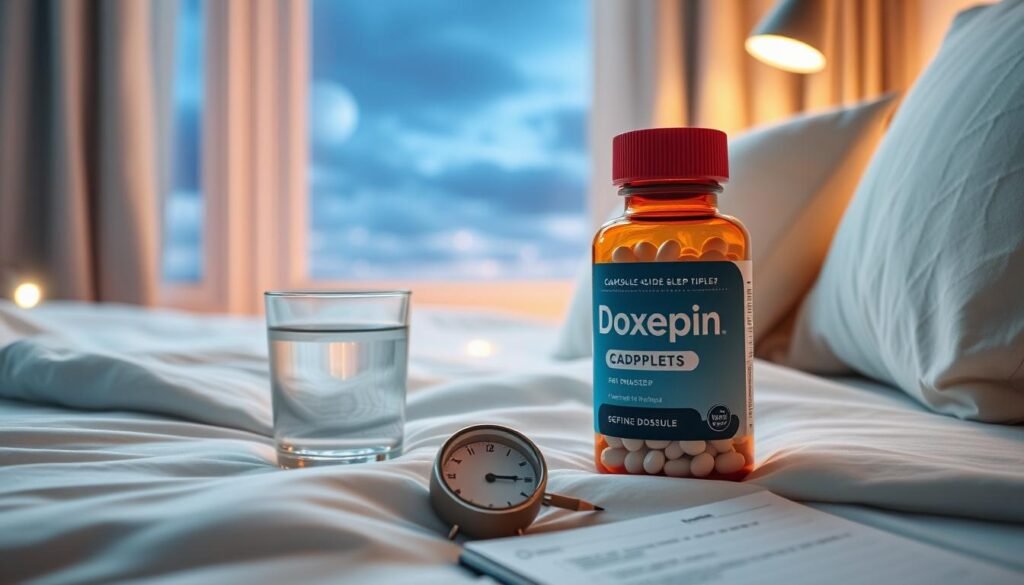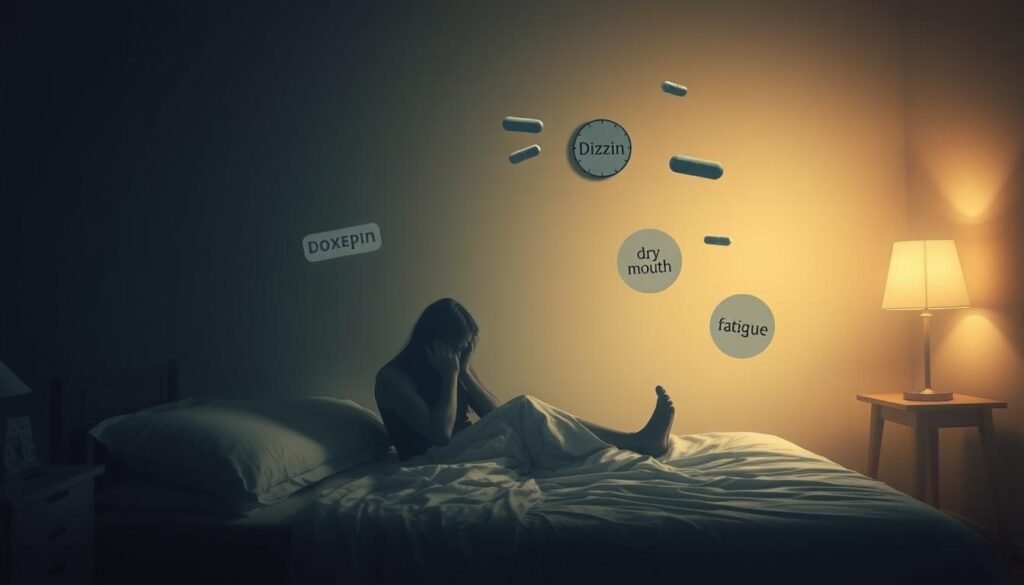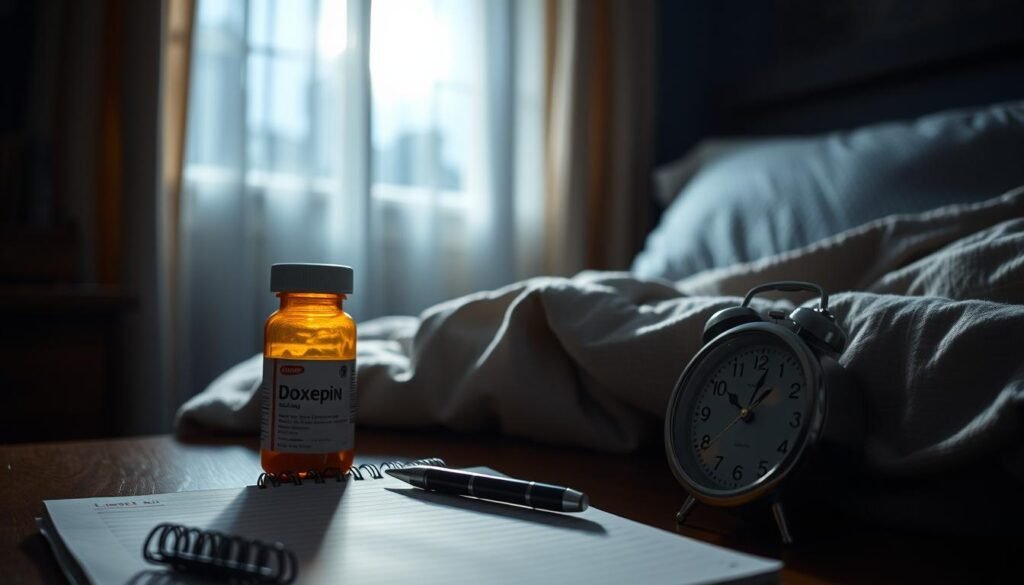Nearly 70 million Americans struggle with sleep disorders, with insomnia at the top of the list. This fact highlights the urgent need for effective treatment options. Doxepin stands out as a promising solution for those looking for relief from insomnia. It’s approved by the FDA for this use, as well as for major depressive disorder, anxiety, and skin pruritus. Knowing the right doxepin dosage for insomnia is key to getting the most out of this medication while keeping side effects to a minimum.
This guide dives into doxepin’s role as a sleep aid. It covers the recommended dosages, safety tips, and additional advice to improve sleep quality and health. Recent studies show that the correct dosage significantly improves sleep and mental health.
Key Takeaways
- Doxepin is mainly used to treat insomnia and related issues.
- The typical dose for insomnia ranges from 3–6 milligrams per day, for up to 4–8 weeks.
- Avoid taking doxepin right after eating.
- Talking to a healthcare provider before starting doxepin is essential for safety, especially to avoid drug interactions.
- Possible side effects include headaches, drowsiness, and heart issues.
- Regular check-ups are important for adjusting the dosage correctly.
- Not everyone may be a good candidate for doxepin, especially with certain health conditions.
Understanding Doxepin as a Sleep Aid
Doxepin is widely known by its brand name, Silenor. It helps people who have trouble staying asleep. Originally designed as a type of antidepressant, its role has expanded. Now, it’s also used to help older adults sleep better.
It got the green light from the FDA in the USA in 2010 for insomnia. At lower doses, it works well for sleep issues.
What is Doxepin?
Doxepin is a medication for insomnia. It works by making the brain feel more sleepy. This is because it blocks certain receptors in the brain.
It’s crucial to take it about 30 minutes before going to bed. Eating right before taking it might lower its power. The typical dose for sleep issues is between 3 mg and 6 mg.
How Does Doxepin Work for Insomnia?
Doxepin boosts sleep quality and length by acting on the brain. It helps by maintaining certain neurotransmitters, which reduces anxiety. This makes sleep deeper and more refreshing.
It helps people stay asleep longer and sleep more soundly. If sleep doesn’t get better in 7-10 days, one should consult a doctor. You can find in-depth studies on its benefits here.
Recommended Doxepin Dosage for Insomnia
Knowing the proper dosage of doxepin for insomnia is key. The right amount can vary based on individual needs. Getting the dosage correct is crucial for the treatment to work well.
Standard Dosage Guidelines
The usual dose for treating insomnia is 25 mg to 50 mg taken orally at bedtime. Dosages might be adjusted over time. The highest dose shouldn’t go over 100 mg a day. Going higher doesn’t necessarily make it work better but could increase side effects.
Factors Affecting Dosage Adjustment
Dosage changes might be needed because of several reasons. Here they are:
- Age: Older adults often need smaller doses due to their bodies’ reactions.
- Overall Health: Health issues might lead to dose adjustments.
- Concurrent Medications: Some drugs can affect how doxepin works, needing dose changes.
- Side Effects: If side effects occur, adjusting the dose can help.
It’s important to keep checking in with your doctor. This ensures the dose is still right and working as intended.
| Dosage Level | Indication | Potential Side Effects |
|---|---|---|
| 25 mg to 50 mg | Starting dosage for insomnia | Minimal |
| 50 mg to 100 mg | Adjustments based on tolerance | Increased sedation, dry mouth |
| Above 100 mg | Maximum dosage | Increased risk of adverse effects |

Safety Precautions When Taking Doxepin
Taking doxepin for insomnia brings potential benefits. However, it’s vital to know the safety precautions. Knowing the doxepin side effects and medication interactions greatly improves sleep safety.
Potential Side Effects
Doxepin can cause several side effects, such as:
- Sedation and dizziness
- Dry mouth
- Constipation
Severe reactions may happen, especially in younger adults. Thoughts of suicide might increase. There have been cases of sleep-driving or preparing food while asleep. It shows how crucial it is to watch how one reacts to this medication.
Interactions with Other Medications
Doxepin’s interaction with other substances is critical to understand. Mixing it with CNS depressants or certain antidepressants like Viibryd can make side effects worse. This includes more sedation.
Other drugs and supplements could affect liver enzymes. This may raise the risk of harmful effects. Patients must talk to their doctors before taking any new herbal or non-prescription medications with doxepin. This ensures sleep safety.
For more information and safe practices on treating insomnia, explore additional resources on effective medication options here.

Monitoring Doxepin Efficacy
Using doxepin for insomnia requires keeping tabs on how well it works. This step is key to getting the best results. Adjusting doses helps avoid side effects. Also, regular check-ups help doctors and patients work together better.
Importance of Regular Follow-ups
Seeing how patients are doing over time is crucial with doxepin. Through regular meetings, doctors can spot any side effects early. This careful watching helps keep patients safe and supported during their treatment.
Signs That Doxepin Is Working
It’s important for patients to know if their treatment is effective. Look out for these signs:
- Improved sleep quality: You’ll notice you’re sleeping better and waking up less.
- Longer total sleep duration: You’re sleeping longer overall.
- Decreased frequency of nighttime awakenings: There are fewer interruptions during your sleep.
Noticing these changes helps figure out if the treatment is a success. It also lets people keep their doctors updated.

Doxepin and Sleep Disorders Beyond Insomnia
Doxepin works as a sleep aid and treats anxiety and depression. It has special qualities for those struggling with these issues and insomnia. It enhances mood and improves sleep, greatly affecting well-being.
Use in Treating Anxiety and Depression
Doxepin helps control anxiety and depression, acting as a mood stabilizer. It reduces anxiety, making it easier to sleep well. This shows that doxepin not only eases mental distress but also promotes better sleep, enhancing life quality.
Comparing Doxepin to Other Medications
Doxepin is less likely to cause dependence than benzodiazepines. Benzodiazepines can lead to severe withdrawal in 15% to 40% of long-term users. Doxepin, at low doses, is good for treating insomnia without causing withdrawal. It is also useful for sleep-maintenance insomnia, providing a safe choice for those not helped by common sleep meds. Its ability to treat depression shows its wide-ranging benefits.
Insomnia sends over 5.5 million people to doctors each year, often affecting women during hormonal changes. Doxepin offers a comprehensive treatment, addressing various mental health issues.
For more about sleep deprivation and its effects, visit this article.
Doxepin vs. Other Insomnia Treatments
Looking at different ways to treat insomnia shows doxepin’s strengths. It stands out against benzodiazepines and natural sleep aids. For those finding it hard to sleep, doxepin is an attractive option.
How Doxepin Compares to Benzodiazepines
Doxepin has a lower addiction risk than drugs like Ambien. It’s safer for treating insomnia over a long time. It also helps with mood disorders. Research shows doxepin greatly improves sleep quality.
A 3 mg dose of doxepin increases the time it takes to fall asleep by 12%. It also increases the time you stay asleep by 22% more than a placebo. Unlike benzodiazepines, doxepin doesn’t have strict usage limits. The FDA has okayed it for ongoing insomnia management without these constraints.
Natural Alternatives to Consider
People often look to natural sleep aids like melatonin and valerian root. These can ease insomnia symptoms. Adding good sleep habits and ways to lower stress can make sleep better.
Talking to a doctor is key when using these natural methods. They make sure these ways work well with any other treatments and avoid bad reactions.
Dosing Considerations for Special Populations
When prescribing doxepin, we must focus on certain groups, like children and the elderly. These groups need extra attention from doctors. They have special health considerations.
Children and Adolescents
Doxepin isn’t usually recommended for kids without thorough checks. Kids can react differently to it, with a higher suicide risk. If a child needs doxepin, doctors should watch them closely for any bad effects.
Elderly Patients and Doxepin Usage
Elderly patients should start with lower doses of doxepin. As we get older, our bodies handle drugs differently. This can make seniors more sensitive to doxepin’s effects. Doctors need to balance the good and bad, considering other health issues and medicines.
To learn more about doxepin, including its interactions and safety steps, check out important info on doxepin. It’s key to talk with doctors about it, especially when dosing for special groups.
Research Insights on Doxepin and Insomnia
Studies into doxepin’s effect on insomnia have been eye-opening. They show its value at low doses for better sleep and easing insomnia symptoms. In March 2010, the FDA recognized doxepin’s benefits for sleep issues. It is available in 3 mg and 6 mg tablets. These have proven helpful, especially for those who often wake up at night or too early in the morning.
Clinical Studies and Findings
Clinical trials lasting three months have shown doxepin’s power against insomnia. It works at both low and high doses, like 10, 25, and 50 mg. A key discovery is that 6 mg doxepin hits its peak in the bloodstream around 3.5 hours if taken without food. The effect grows with the dosage. Given its status as a non-controlled substance, low-dose doxepin is a favorable option over standard insomnia drugs.
Patient Testimonials and Outcomes
People taking doxepin have mostly good things to say. They’ve noticed big improvements in how they sleep, with few side effects. This makes doxepin a standout choice. Users report not just longer sleep times, but better sleep quality too. Such feedback underlines the importance of tailoring treatments to each person. This idea is crucial, particularly with new methods for diagnosing sleep disorders, as seen in the ICD 10 code for insomnia.
| Dosage (mg) | Cmax Time (hours) | Frequency of Use | Effectiveness |
|---|---|---|---|
| 3 | 3.5 | Daily | Significant reduction in insomnia symptoms |
| 6 | 3.5 | Daily | Enhanced sleep quality reported |
| 10 | Varies | As needed | Effective for severe cases |
Conclusion
Doxepin is becoming popular for treating insomnia. It works well because it helps with sleep and mood. The doxepin insomnia treatment summary says it’s good at fixing sleep schedules. It does this at low doses, which is safe for adults and older people wanting better sleep. Studies show that doxepin helps people fall asleep faster and sleep longer. It also helps with anxiety, according to the doxepin overall benefits.
When thinking about doxepin, patients need to watch their dosage closely. They also need to know about possible side effects. Talking to doctors can help use doxepin safely, avoiding problems that other sleep drugs might cause. Adding therapy, like cognitive-behavioral therapy, can make treatment even better. Such a mix can greatly improve sleep quality, as noted in this sleep aid conclusion.
Doxepin is proving to be a smart choice for insomnia. It can make a big difference for people with sleep problems. Working with doctors and exploring all options can help patients fight insomnia. This leads to better sleep, happiness, and life quality.
Want to know more about the science behind doxepin? Here is a helpful article you can read.